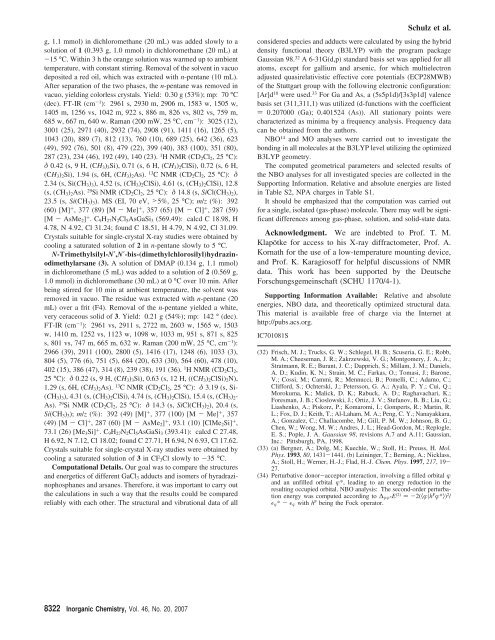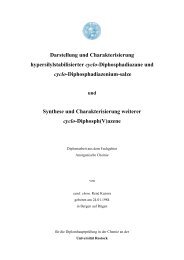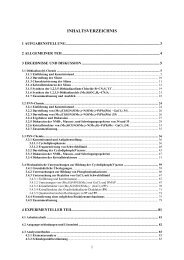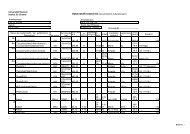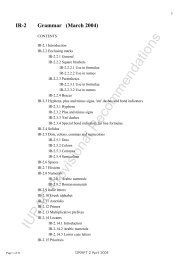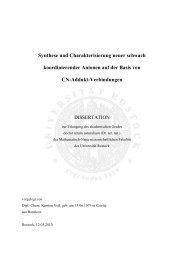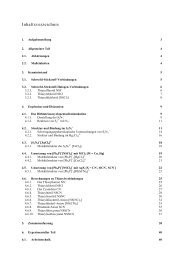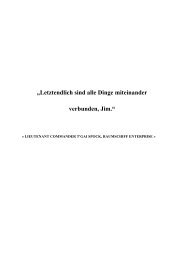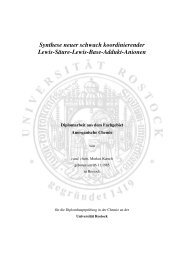Darstellung und Charakterisierung neuer niedrigkoordinierter ...
Darstellung und Charakterisierung neuer niedrigkoordinierter ...
Darstellung und Charakterisierung neuer niedrigkoordinierter ...
Create successful ePaper yourself
Turn your PDF publications into a flip-book with our unique Google optimized e-Paper software.
g, 1.1 mmol) in dichloromethane (20 mL) was added slowly to a<br />
solution of 1(0.393 g, 1.0 mmol) in dichloromethane (20 mL) at<br />
-15 °C. Within 3 h the orange solution was warmed up to ambient<br />
temperature, with constant stirring. Removal of the solvent in vacuo<br />
deposited a red oil, which was extracted with n-pentane (10 mL).<br />
After separation of the two phases, the n-pentane was removed in<br />
vacuo, yielding colorless crystals. Yield: 0.30 g (53%); mp: 70 °C<br />
(dec). FT-IR (cm -1 ): 2961 s, 2930 m, 2906 m, 1583 w, 1505 w,<br />
1405 m, 1256 vs, 1042 m, 922 s, 886 m, 826 vs, 802 vs, 759 m,<br />
685 w, 667 m, 640 w. Raman (200 mW, 25 °C, cm -1 ): 3025 (12),<br />
3001 (25), 2971 (40), 2932 (74), 2908 (91), 1411 (16), 1265 (5),<br />
1043 (20), 889 (7), 812 (13), 760 (10), 689 (25), 642 (36), 623<br />
(49), 592 (76), 501 (8), 479 (22), 399 (40), 383 (100), 351 (80),<br />
287 (23), 234 (46), 192 (49), 140 (23). 1 H NMR (CD2Cl2, 25°C):<br />
δ 0.42 (s, 9 H, (CH3)3Si), 0.71 (s, 6 H, (CH3)2ClSi), 0.72 (s, 6 H,<br />
(CH3)2Si), 1.94 (s, 6H, (CH3)2As). 13 C NMR (CD2Cl2, 25°C): δ<br />
2.34 (s, Si(CH3)3), 4.52 (s, (CH3)2ClSi), 4.61 (s, (CH3)2ClSi), 12.8<br />
(s, (CH3)2As). 29 Si NMR (CD2Cl2, 25°C): δ 14.8 (s, SiCl(CH3)2),<br />
23.5 (s, Si(CH3)3). MS (EI, 70 eV, >5%, 25 °C); m/z (%): 392<br />
(60) [M] + , 377 (89) [M - Me] + , 357 (65) [M - Cl] + , 287 (59)<br />
[M - AsMe2] + .C9H27N2Cl5AsGaSi3 (569.49): calcd C 18.98, H<br />
4.78, N 4.92, Cl 31.24; fo<strong>und</strong> C 18.51, H 4.79, N 4.92, Cl 31.09.<br />
Crystals suitable for single-crystal X-ray studies were obtained by<br />
cooling a saturated solution of 2 in n-pentane slowly to 5 °C.<br />
N-Trimethylsilyl-N′,N′-bis-(dimethylchlorosilyl)hydrazinodimethylarsane<br />
(3). A solution of DMAP (0.134 g, 1.1 mmol)<br />
in dichloromethane (5 mL) was added to a solution of 2 (0.569 g,<br />
1.0 mmol) in dichloromethane (30 mL) at 0 °C over 10 min. After<br />
being stirred for 10 min at ambient temperature, the solvent was<br />
removed in vacuo. The residue was extracted with n-pentane (20<br />
mL) over a frit (F4). Removal of the n-pentane yielded a white,<br />
very ceraceous solid of 3. Yield: 0.21 g (54%); mp: 142 ° (dec).<br />
FT-IR (cm -1 ): 2961 vs, 2911 s, 2722 m, 2603 w, 1565 w, 1503<br />
w, 1410 m, 1252 vs, 1123 w, 1098 w, 1033 m, 951 s, 871 s, 825<br />
s, 801 vs, 747 m, 665 m, 632 w. Raman (200 mW, 25 °C, cm -1 ):<br />
2966 (39), 2911 (100), 2800 (5), 1416 (17), 1248 (6), 1033 (3),<br />
804 (5), 776 (6), 751 (5), 684 (20), 633 (30), 564 (60), 478 (10),<br />
402 (15), 386 (47), 314 (8), 239 (38), 191 (36). 1 H NMR (CD2Cl2,<br />
25 °C): δ 0.22 (s, 9 H, (CH3)3Si), 0.63 (s, 12 H, ((CH3)2ClSi)2N),<br />
1.29 (s, 6H, (CH3)2As). 13 C NMR (CD2Cl2, 25°C): δ 3.19 (s, Si-<br />
(CH3)3), 4.31 (s, (CH3)2ClSi), 4.74 (s, (CH3)2ClSi), 15.4 (s, (CH3)2-<br />
As). 29 Si NMR (CD2Cl2, 25°C): δ 14.3 (s, SiCl(CH3)2), 20.4 (s,<br />
Si(CH3)3); m/z (%): 392 (49) [M] + , 377 (100) [M - Me] + , 357<br />
(49) [M - Cl] + , 287 (60) [M - AsMe2] + , 93.1 (10) [ClMe2Si] + ,<br />
73.1 (26) [Me3Si] + .C9H27N2Cl5AsGaSi3 (393.41): calcd C 27.48,<br />
H 6.92, N 7.12, Cl 18.02; fo<strong>und</strong> C 27.71, H 6.94, N 6.93, Cl 17.62.<br />
Crystals suitable for single-crystal X-ray studies were obtained by<br />
cooling a saturated solution of 3 in CF3Cl slowly to -35 °C.<br />
Computational Details. Our goal was to compare the structures<br />
and energetics of different GaCl3 adducts and isomers of hyradrazinophosphanes<br />
and arsanes. Therefore, it was important to carry out<br />
the calculations in such a way that the results could be compared<br />
reliably with each other. The structural and vibrational data of all<br />
8322 Inorganic Chemistry, Vol. 46, No. 20, 2007<br />
considered species and adducts were calculated by using the hybrid<br />
density functional theory (B3LYP) with the program package<br />
Gaussian 98. 32 A 6-31G(d,p) standard basis set was applied for all<br />
atoms, except for gallium and arsenic, for which multielectron<br />
adjusted quasirelativistic effective core potentials (ECP28MWB)<br />
of the Stuttgart group with the following electronic configuration:<br />
[Ar]d 10 were used. 33 For Ga and As, a (5s5p1d)/[3s3p1d] valence<br />
basis set (311,311,1) was utilized (d-functions with the coefficient<br />
) 0.207000 (Ga); 0.401524 (As)). All stationary points were<br />
characterized as minima by a frequency analysis. Frequency data<br />
can be obtained from the authors.<br />
NBO 14 and MO analyses were carried out to investigate the<br />
bonding in all molecules at the B3LYP level utilizing the optimized<br />
B3LYP geometry.<br />
The computed geometrical parameters and selected results of<br />
the NBO analyses for all investigated species are collected in the<br />
Supporting Information. Relative and absolute energies are listed<br />
in Table S2, NPA charges in Table S1.<br />
It should be emphasized that the computation was carried out<br />
for a single, isolated (gas-phase) molecule. There may well be significant<br />
differences among gas-phase, solution, and solid-state data.<br />
Acknowledgment. We are indebted to Prof. T. M.<br />
Klapötke for access to his X-ray diffractometer, Prof. A.<br />
Kornath for the use of a low-temperature mounting device,<br />
and Prof. K. Karagiosoff for helpful discussions of NMR<br />
data. This work has been supported by the Deutsche<br />
Forschungsgemeinschaft (SCHU 1170/4-1).<br />
Supporting Information Available: Relative and absolute<br />
energies, NBO data, and theoretically optimized structural data.<br />
This material is available free of charge via the Internet at<br />
http://pubs.acs.org.<br />
IC701081S<br />
Schulz et al.<br />
(32) Frisch, M. J.; Trucks, G. W.; Schlegel, H. B.; Scuseria, G. E.; Robb,<br />
M. A.; Cheeseman, J. R.; Zakrzewski, V. G.; Montgomery, J. A., Jr.;<br />
Stratmann, R. E.; Burant, J. C.; Dapprich, S.; Millam, J. M.; Daniels,<br />
A. D.; Kudin, K. N.; Strain, M. C.; Farkas, O.; Tomasi, J.; Barone,<br />
V.; Cossi, M.; Cammi, R.; Mennucci, B.; Pomelli, C.; Adamo, C.;<br />
Clifford, S.; Ochterski, J.; Petersson, G. A.; Ayala, P. Y.; Cui, Q.;<br />
Morokuma, K.; Malick, D. K.; Rabuck, A. D.; Raghavachari, K.;<br />
Foresman, J. B.; Cioslowski, J.; Ortiz, J. V.; Stefanov, B. B.; Liu, G.;<br />
Liashenko, A.; Piskorz, P.; Komaromi, I.; Gomperts, R.; Martin, R.<br />
L.; Fox, D. J.; Keith, T.; Al-Laham, M. A.; Peng, C. Y.; Nanayakkara,<br />
A.; Gonzalez, C.; Challacombe, M.; Gill, P. M. W.; Johnson, B. G.;<br />
Chen, W.; Wong, M. W.; Andres, J. L.; Head-Gordon, M.; Replogle,<br />
E. S.; Pople, J. A. Gaussian 98, revisions A.7 and A.11; Gaussian,<br />
Inc.: Pittsburgh, PA, 1998.<br />
(33) (a) Bergner, A.; Dolg, M.; Kuechle, W.; Stoll, H.; Preuss, H. Mol.<br />
Phys. 1993, 80, 1431-1441. (b) Leininger, T.; Berning, A.; Nicklass,<br />
A.; Stoll, H.; Werner, H.-J.; Flad, H.-J. Chem. Phys. 1997, 217, 19-<br />
27.<br />
(34) Perturbative donor-acceptor interaction, involving a filled orbital <br />
and an unfilled orbital *, leading to an energy reduction in the<br />
resulting occupied orbital. NBO analysis: The second-order perturbation<br />
energy was computed according to ∆*E (2) )-2(〈|h F *〉) 2 /<br />
ǫ* - ǫ with h F being the Fock operator.


